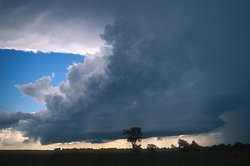Cumulonimbus
|
|
Cumulonimbus is a type of cloud that is tall, dense, and involved in thunderstorms and other bad weather. The clouds can form alone, in clusters, or along a cold front in a squall line.
Formation
To create a cumulonimbus cloud, you need three ingredients.
- Plenty of moisture.
- A mass of warm unstable air.
- A source of energy to lift the warm, moist air mass rapidly upward.
Typically, the clouds form around front lines, near oceans where sea breezes provide the storm energy, or over mountains which push the air upwards.
When the warm air rises above the typically cooler air above it, it starts to cool and the water vapor condenses into water droplets. This adds more energy to the cloud, which soon becomes self-sustaining. As the air mass continues to rise, the water droplets continue to cool and form ice crystals. Gravity causes these droplets and crystals to start to fall, causing a downward movement to compete with the upward lift.
Instability between the updrafts and downdrafts causes static electrical charges to build up in the cumulonimbus cloud. The discharge of this electricity causes thunder and lightning.
During the spring and summer, cumulonimbus clouds are more likely to form in the afternoon, due to the heating of the earth's surface. However, they can also form along a cold front when the warm buoyant air is forced upward by the heavier cold air mass that cuts under the warmer air like a wedge. This can happen at any time of the year, as demonstrated by thunderstorms that happen in conjunction with snowstorms in the winter.
Appearance
The base of a cumulonimbus can be several miles across, and it can be tall enough to occupy middle as well as low altitudes: though formed at an altitude of about 3,000 to 4,000 metres (10,000 to 12,000 feet), its peak can reach up to 23,000 metres (75,000 feet) in extreme cases. Typically, it peaks at a much lower height.
Cumulonimbus are also characterized by a flat, anvil-like top (the anvil dome), caused by straight line winds at the higher altitudes which shear off the top of the cloud. This anvil shape can precede the main cloud structure for many miles, causing anvil lightning.
Effects
Cumulonimbus storm cells can produce heavy rain (particularly of a convective nature) and flash flooding, as well as straight-line winds. Most storm cells die after about 20 minutes, when the precipitation causes more downdraft than updraft, causing the energy to dissipate. If there is enough solar energy in the atmosphere, however (on a hot summer's day, for example), the moisture from one storm cell can evaporate rapidly -- resulting in a new cell forming just a few miles from the former one. This can cause thunderstorms to last for several hours.
Cumulonimbus clouds contain severe convection currents, with very high, unpredictable winds, particularly in the vertical plane (updrafts and downdrafts). They are therefore extremely dangerous to aircraft. Smaller propeller-driven planes cannot cope with the conditions and must fly around them; larger jet aircraft fly over the smaller ones and around larger examples. Larger planes are also equipped with weather radar and wind shear detectors to help guide them through, in the event that they need to pass through such clouds to land.
The air convection can also form mesocyclones, which can cause hail and tornadoes.

